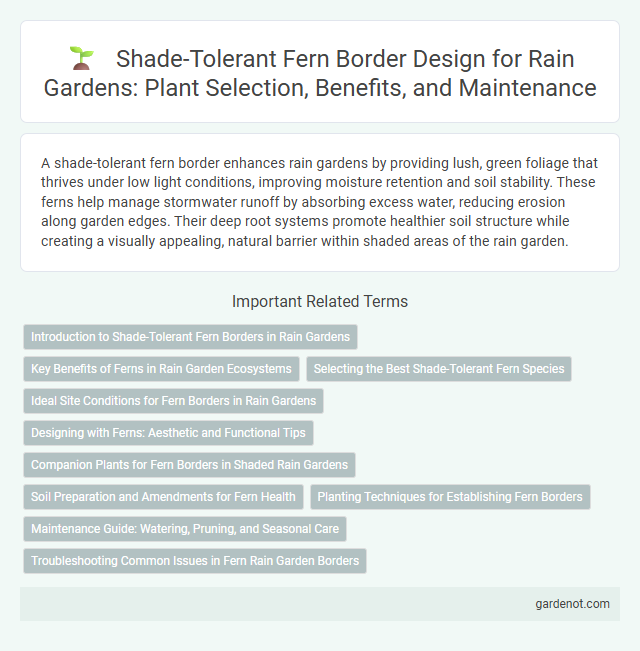A shade-tolerant fern border enhances rain gardens by providing lush, green foliage that thrives under low light conditions, improving moisture retention and soil stability. These ferns help manage stormwater runoff by absorbing excess water, reducing erosion along garden edges. Their deep root systems promote healthier soil structure while creating a visually appealing, natural barrier within shaded areas of the rain garden.
Introduction to Shade-Tolerant Fern Borders in Rain Gardens
Shade-tolerant fern borders enhance rain gardens by providing lush, low-maintenance greenery that thrives in shaded, moist environments. These ferns improve soil stabilization and water absorption while supporting local biodiversity by creating habitat for insects and small wildlife. They are ideal for rain gardens situated under tree canopies or in areas with limited direct sunlight, ensuring effective stormwater management and aesthetic appeal.
Key Benefits of Ferns in Rain Garden Ecosystems
Shade-tolerant ferns in rain garden ecosystems enhance water filtration by efficiently absorbing excess runoff and preventing soil erosion. Their deep root systems improve soil stability and encourage microbial activity, promoting nutrient cycling within the garden. Ferns also provide a resilient, low-maintenance groundcover that supports local biodiversity by offering habitat and moisture retention in shaded environments.
Selecting the Best Shade-Tolerant Fern Species
Selecting the best shade-tolerant fern species for a rain garden involves prioritizing varieties that thrive in low-light, moist conditions such as Lady Fern (Athyrium filix-femina), Christmas Fern (Polystichum acrostichoides), and Japanese Painted Fern (Athyrium niponicum). These species offer resilience against wet soil and provide dense, textured foliage that enhances the garden's aesthetic and ecological functions. Optimizing fern selection based on local climate and soil pH ensures sustainable growth and effective stormwater filtration.
Ideal Site Conditions for Fern Borders in Rain Gardens
Shade-tolerant fern borders thrive in rain gardens with moist, well-drained soil rich in organic matter and partial to full shade conditions. Ideal site conditions include consistent moisture availability without waterlogging, protection from direct afternoon sun, and a stable microclimate that supports fern growth. Proper placement in low-lying areas with filtered light enhances the health and vigor of ferns, promoting effective stormwater filtration and habitat biodiversity.
Designing with Ferns: Aesthetic and Functional Tips
Shade-tolerant ferns such as lady ferns (Athyrium filix-femina) and Japanese painted ferns (Athyrium niponicum) create lush, textured borders in rain gardens that thrive in low-light conditions while enhancing moisture retention. Designing with ferns involves layering varying heights and frond shapes to produce dynamic visual interest and natural transitions between garden zones. These ferns also contribute to soil stabilization and water filtration, improving the ecological function of rain gardens by supporting diverse native wildlife.
Companion Plants for Fern Borders in Shaded Rain Gardens
Shade-tolerant ferns thrive alongside companion plants such as hostas, astilbes, and hellebores, which enhance the moisture retention and aesthetic appeal of shaded rain gardens. These plants contribute to biodiversity and soil stabilization while complementing the fern's texture and color in damp, low-light environments. Selecting native species like wild ginger and foamflower further supports local ecosystems and ensures optimal growth in shaded, water-absorbing garden borders.
Soil Preparation and Amendments for Fern Health
For optimal fern health in a rain garden, soil preparation should focus on well-draining, acidic to neutral soil with a pH between 5.5 and 7.0. Incorporate organic matter such as compost or leaf mold to improve moisture retention and nutrient availability, ensuring the soil remains consistently moist but not waterlogged. Mulching with shredded bark or pine needles helps maintain soil moisture and supports the shade-loving ferns' growth in low-light conditions.
Planting Techniques for Establishing Fern Borders
Shade-tolerant fern borders thrive when planted in well-prepared soil rich in organic matter that retains moisture without becoming waterlogged. Spacing ferns adequately, typically 12 to 18 inches apart, encourages airflow and healthy root development while minimizing disease risk. Applying a mulch layer helps conserve moisture and regulate soil temperature, promoting robust establishment and growth in shaded rain garden areas.
Maintenance Guide: Watering, Pruning, and Seasonal Care
Shade-tolerant ferns in rain garden borders require consistent moisture, especially during dry spells, to maintain lush growth and prevent stress. Pruning involves removing dead or damaged fronds in early spring to promote healthy new shoots and maintain an attractive, tidy appearance. Seasonal care includes mulching in fall to protect roots during winter and monitoring for pests or fungal issues in humid conditions for optimal plant health.
Troubleshooting Common Issues in Fern Rain Garden Borders
Shade-tolerant fern borders in rain gardens often face issues such as poor drainage and fungal infections caused by prolonged moisture. To troubleshoot these problems, ensure proper soil aeration and incorporate mulch to maintain balanced moisture levels while preventing waterlogging. Regular inspection for pests like slugs and timely removal of damaged fronds can enhance the health and resilience of fern borders in rain garden settings.
Shade-tolerant fern border Infographic

 gardenot.com
gardenot.com